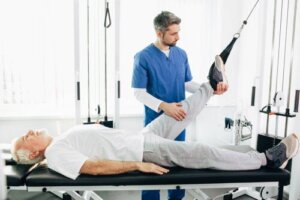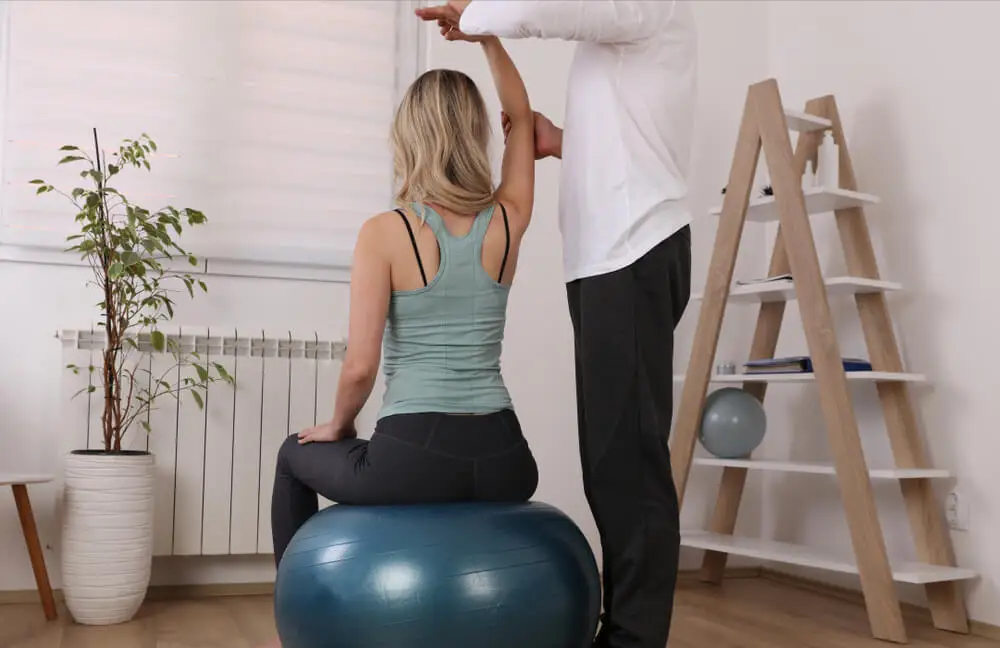What is Kinesiotherapy?


Reviewed and approved by the doctor Leonardo Biolatto
Kinesiotherapy is a practice that’s part of the discipline of physiotherapy. It consists of the application of a series of movements and various techniques, performed by the patients themselves or with the intervention of the therapist.
The exercises are done in order to optimize a person’s general state of health of muscles and joints by stretching and strengthening them. This helps in rehabilitation processes, as well as in the prevention of motor alterations.
This practice does not consist of the use of massages or the application of ointments or bandages. On the contrary, it involves sophisticated techniques (such as electrotherapy or hydrotherapy) and even the use of various types of equipment, implements, devices, and apparatus (such as ultrasounds).
What is kinesiotherapy and what does it consist of?
Kinesiotherapy is also known as Kinesitherapy or kinesiatrics. In all cases, the root is the same, only with phonetic or orthographic variations.
The term in question derives from the Greek word kinesis, which translates as “movement.” With the addition of the word therapy, etymologically speaking, the literal translation of this word would be “movement therapy”.
As such, this set of techniques is part of a broader discipline: physiotherapy. In fact, it could be said that kinesiotherapy consists of the practical application of the principles of kinesiology. However, its purpose is both therapeutic and preventive.
Therefore, it’s oriented toward the treatment, rehabilitation, recovery and prevention of injuries or conditions related to movement.
Thus, at the beginning of the treatment, the therapist performs a test to assess the quality and type of muscle response by locating dysfunctional areas or actions that are performed incorrectly and that can lead to the deterioration of joint, muscle, and even bone health. Once the type of problem has been determined, the kinesiotherapist develops an approach plan.
We think you may also enjoy reading this article: Resting Leg Pain: 7 Possible Causes and What to Do for Relief
Why kinesiotherapy?
In kinesiotherapy, the response of muscles and joints to certain efforts is observed and analyzed to detect possible imbalances. Thus, mobility problems can be corrected and injuries or ailments associated with overexertion, sedentary lifestyles, or poor posture can be prevented.
This is a non-pharmacological alternative for the promotion of health and the treatment of symptoms of various ailments, such as pain, stiffness, or limited movement.
In this sense, it’s curative, preventive, and even formative. And with these techniques, it’s also about educating. The patient becomes aware of his or her body and its movements.
In general terms, the objectives of kinesiotherapy aim to develop or work on aspects such as the following:
- Proprioception and posture
- Power: to increase muscle strength
- Relaxation: to relieve muscle tension
- Accuracy: to improve movement for specific tasks
- Coordination: in the use of various muscles or body parts
- Endurance: to maintain work capacity over time
- Stretching: working on elasticity and range of motion

Classifications of kinesiotherapy
Kinesiotherapy can be classified in several ways, depending on aspects such as the time at which it takes place, its purpose, techniques, and resources. Let’s take a look.
According to the moment
First, we can talk about preventive kinesiotherapy. As its name implies, this type of treatment is applied before injuries occur or problems appear. Or rather, it’s done to prevent them from occurring.
The curative is the one that is practiced after an illness or injury to help recovery. In this order of ideas, a complete rehabilitation program may be proposed.
According to the activity of the patient
Another classification has to do with the activity or intervention of the patient before the treatment. Accordingly, kinesiotherapy can be passive if the movements are not performed voluntarily by the patient but instead by the therapist.
In turn, within the category of passive kinesiotherapy, there are two subtypes:
- Relaxed: This is if the stretching isn’t very demanding or painful.
- Forced: This occurs when the movements reach the limit of the joints.
On the other hand, in the case of active kinesiotherapy, the patient is the one who executes the movements voluntarily, although this is often assisted by a health professional. Within this form, there are two modalities:
- Assisted kinesiotherapy
- Resisted kinesiotherapy
In the first case, the patient is not able to perform the complete movement, so he/she is totally or partially assisted, manually or instrumentally. In the second form, manual or instrumental resistances are applied (with pulleys, springs, weights, or even underwater).
According to the field of application
The best-known field of application of kinesiotherapy is the health field – that is, the development of rehabilitation programs or complementary treatments for patients with various diseases that affect their movement.
For its part, in the sports field, kinesiotherapy works with athletes of any level to improve their performance or to help them in their recovery after an injury.
In the educational area, it also has a wide field of work. It’s applied in special education, psychomotor integration, and early stimulation centers. This is due to the fact that some children may present articular or muscular problems, such as hypotonia.
Depending on the purpose
Most commonly, kinesiotherapy works on the motor aspect, or movement. This is done in the rehabilitation of patients with injuries (such as tendinitis) or with diseases such as osteoarthritis or spondylitis.
However, it’s also applied to people who are bedridden by some disease, to quadriplegic patients, and even to those in a coma, in order to preserve the strength and mobility of their muscles and joints. In addition, kinesiotherapy exercises are practiced to improve respiratory mechanics. This is done, for example, in patients with problems such as chronic obstructive pulmonary disease (COPD).
Finally, in terms of purpose, there’s also postural kinesiotherapy to help correct the way we sit or stand. Neck and back pain can be prevented this way.
Like this article? You may also like to read: Infiltrations: The Technique that Helps Relieve Pain and Injuries
The benefits of kinesiotherapy
Kinesiotherapy helps from a physical and mental point of view, and it does this not only in those who suffer from an injury or illness. Among the various benefits it provides are the following:
- It improves cardiorespiratory mechanics when exercising.
- It reduces pain and joint and muscle stiffness.
- Kinesiotherapy contributes to stress and anxiety management.
- It increases proprioception of movement.
- A person’s range of motion is recovered.
- It strengthens the musculature.
- It helps to prevent injuries.

For whom is it recommended?
Anyone can use kinesiotherapy, because we’re never exempt from suffering from an injury, a contracture, bad posture, or pain. In particular, it’s recommended in the following cases:
- Lumbago
- Facial paralysis
- Coma patients
- Muscle contractures
- Hamstring injury
- People with hypotonia
- Shoulder overexertion
- Patellar chondromalacia
- Cardiorespiratory problems
- Nervous system, sensory or motor disorders
- Patients with ankylosis, rheumatic arthropathies, or periarthritis
Risks and contraindications
Notwithstanding the benefits mentioned above, there are certain situations in which kinesiotherapy should not be applied:
- Fractures
- Joint effusion
- Hyperlaxity
- Infections
Kinesiotherapy is a professional treatment
For kinesiotherapy, the patient does not need any special preparation. Nor is anesthesia required. However, this doesn’t mean that it should be taken lightly or done by just anyone.
On the contrary, the exercises should be performed by or under the guidance of a professional physiotherapist in an environment and with quality, professional furniture and equipment.
Similarly, when a work plan is developed and elaborated, it should be done individually, according to the needs of each patient. Above all, the plan must be approved by a physician, whether this be a traumatologist or a doctor with another specialty.
All cited sources were thoroughly reviewed by our team to ensure their quality, reliability, currency, and validity. The bibliography of this article was considered reliable and of academic or scientific accuracy.
- Álvarez-Sala J, Cimas E, Masa J, et al. Recomendaciones para la atención al paciente con enfermedad pulmonar obstructiva crónica. Archivos de Bronconeumología. 2001; 37(7): 269-278.
- García-Saiz J. Revisión selectiva de la importancia de la fisioterapia en el paciente adulto en estado de coma estructural no traumático. Valladolid: Universidad de Valladolid, 2018.
- Granillo Z, Ruiz Á, Rivera S, et al. Aquatic neurotherapy treatment in children smaller than 4 years. Plasticidad y Restauración Neurológica. 2006; 5(1): 25-29.
- Maldonado C. Efectividad de la planificación terapéutica en lesiones cápsulo ligamentosas de tobillo en jugadores/as de futbol seleccionados de Ecuador en el 2013. Quito: Pontificia Universidad Católica del Ecuador, 2014
- Marcos A. Revisión sobre cuidados y terapias complementarias en la enfermedad de Parkinson. Salamanca: Universidad de Salamanca, 2019.
- Pintado-García V. Espondilitis infecciosa. Enfermedades Infecciosas y Microbiología Clínica. 2008: 26 (8): 510-517.
- Poalasin L, Santamaría J. Kinesioterapia para el mantenimiento de la capacidad funcional de los adultos mayores que presentan artritis reumatoide en el hogar de ancianos instituto Estupiñán de la ciudad de Latacunga en el periodo agosto 2012 – febrero 2013. Riobamba: Universidad Nacional de Chimborazo, 2013.
- Rodríguez López E, Semanat M, Limonta I, Hechavarría S. Rehabilitación integral al adulto mayor. Clínica vs tecnología. Revista Cubana de Tecnología de la Salud [Internet]. 2014. URL: http://www.revtecnologia.sld.cu/index.php/tec/article/view/331.
This text is provided for informational purposes only and does not replace consultation with a professional. If in doubt, consult your specialist.








